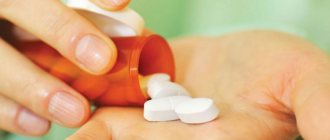What painkillers can you take while breastfeeding?
When breastfeeding, it is safe to take the following painkillers: Paracetamol, Ibuprofen, Drotaverine (“No-shpa”), Ketorolac (“Ketorol”, “Ketanov”, “Ketalgin”). Injections of lidocaine or articaine are suitable for pain relief during dental treatment. For local anesthesia for bruises and some other injuries, you can use ointments based on diclofenac.
| Allowed | Prohibited |
| Paracetamol | Metamizole sodium (Analgin) |
| Ibuprofen | Nimesulide (“Nimesil”, “Nise”) |
| Drotaverine ("No-shpa") | Acetylsalicylic acid (“Citramon”, “Aspirin”) |
| Ketorolac (“Ketorol”, “Ketanov”, “Ketalgin”) |
Should you breastfeed if you have nipple pain?
Unless your doctor advises otherwise, try to maintain your normal breastfeeding routine despite nipple pain. Interruptions or cessation of feedings may result in decreased milk production.
You can use a breast pump until your nipples become less painful, sometimes causing less irritation to your nipple skin.
Even if you have a breast infection like mastitis, you should continue to breastfeed. In addition, with mastitis, pain in the breasts and nipples even increases when breastfeeding or pumping stops.
In the same way, you should continue breastfeeding if you have thrush, unless your doctor recommends otherwise.
Terms of use
Dr. Komarovsky, for example, recommends avoiding the use of painkillers while breastfeeding or pregnant, as some drugs simply have not undergone proper clinical studies. However, if a woman cannot tolerate severe pain, there is no point in waiting for it to go away on its own or using dubious traditional methods. Here are a few rules that will help you quickly deal with the problem and avoid harming yourself and your child:
- It is important to understand: painkillers only relieve the symptom, but do not cure the disease itself. Therefore, in case of painful discomfort, it is recommended to consult a doctor, find the cause of the discomfort and eliminate it. So, if you have a toothache, visit the dentist; if you have pain in your ear, visit an ENT doctor. If the root cause is not eliminated, the pain will occur again and again, requiring another dose of medication.
- Even for a drug prescribed by a doctor, check the instructions, or rather the section “Use during pregnancy and breastfeeding.” There are no prohibitions - take it, and in the recommended dosage. But! The quantitative transfer of drugs into mother's milk has been studied only for a few drugs. Therefore, in most cases, you will see that the drug has not been studied during pregnancy and lactation, or pregnancy and lactation are contraindications for use (precisely due to the lack of studies on this group). Some mothers try to reduce the harm of drugs by reducing the dose. It is not recommended to do this; the expected effect will not happen (especially if we are talking about products that are acceptable during breastfeeding!).
- Look in the instructions for an indicator that is important for us - the drug elimination period. As a rule, it is the same for blood plasma and breast milk. This way you can calculate the period when the drug leaves your body. Analgesics penetrate into the blood and into mother's milk at the same time: this requires only half an hour, the maximum concentration occurs after 1–1.5 hours. And they appear longer – up to 2–7. The half-life of paracetamol, for example, is about 3, and acetylsalicylic acid - up to 7.
Causes of the disease
In the vast majority of cases, problems with the mammary gland do not arise on their own, but as a result of not entirely properly organized breastfeeding.
The Academy of Breastfeeding Medicine is an international organization whose main goal is to create basic clinical recommendations to solve the most common problems that threaten breastfeeding. Thus, in March 2014, an updated protocol for the management of lactation mastitis was released.
The document lists factors that increase the risk of lactostasis as a trigger for the disease:
- rare feedings, including “clockwise”, as well as skipping them;
- improper latching on the breast by the baby and/or his inability to suck milk effectively;
- hyperlactation;
- blockage of the milk ducts, including in the area of the outlet on the nipple (calcifications, casein masses), or “overgrowth” of the latter, which may be accompanied by local inflammation;
- compression of the mammary glands (for example, by a tight bra);
- abrupt weaning;
- stress and fatigue of the mother, her illness, as well as the illness of the child;
Dental treatment
Some young mothers are afraid to go for dental treatment because they read somewhere that anesthesia can have a bad effect on the quality of breast milk. In reality, this is not so: the doctor gives a local injection, which has a short-term effect and is quickly eliminated from the body, and therefore does not cause any harm to the baby’s health? As stated in the online magazine “Doctor Zubov”. So it is possible and necessary to treat teeth with pain relief during lactation. It is better to clarify in advance which drug will be administered to you, and inform the dentist about breastfeeding. In this case, the doctor will select the optimal remedy that will not only provide excellent pain relief during dental treatment, but will also be eliminated from the body as quickly as possible.
Use of ketorolac during pregnancy and possible complications for the fetus
Ketorolac belongs to the group of non-steroidal anti-inflammatory drugs; it has pronounced analgesic, anti-inflammatory and slight antipyretic properties.
It works by stopping the body from producing a substance that causes pain, fever and inflammation. The strength of the analgesic effect is comparable to morphine, significantly superior to other NSAIDs. It is used to treat moderately severe acute pain that requires opioid-level pain relief (narcotic analgesics). The US Food and Drug Administration (FDA), as a result of studies on ketorolac, found that the use of ketorolac in the second half of pregnancy can cause the following complications:
- premature closure of the fetal ductus arteriosus;
- fetal renal failure;
- suppression of platelet aggregation and delay of labor.
Around 20 weeks into pregnancy, the fetus's kidneys begin to produce most of the amniotic fluid, so kidney problems can cause low levels of this protective fluid. Low amniotic fluid levels usually go away when a pregnant woman stops taking ketorolac, according to the FDA.
The FDA also warned that using ketorolac after 30 weeks of pregnancy increases the risk of heart problems in unborn children.
An FDA study in 2022 found 35 cases of pregnant women who took ketorolac resulting in low amniotic fluid levels and maternal kidney problems, resulting in five newborn deaths, two with kidney failure and confirmed low levels. amniotic fluid, and three more also had renal failure, but without confirmed low amniotic fluid levels.
In addition, there were 11 reports of low amniotic fluid levels during pregnancy, but the fluid volume returned to normal after stopping ketorolac.
According to the Centers for Disease Control and Prevention (CDC), complications of prolonged oligohydramnios (oligohydramnios) may include:
- contracture of the limbs (limitation of joint mobility);
- delayed lung maturation.
Some post-marketing cases of kidney dysfunction in newborns have required invasive procedures such as exchange transfusion or dialysis (a procedure that helps remove toxic substances and excess water from the body). In other cases, the condition was reversible within 3 to 6 days after stopping ketorolac and in these cases reappeared when it was restarted.
Based on all the above studies by the US Food and Drug Administration (FDA), they do not recommend its use during pregnancy, especially ketorolac is contraindicated in the third trimester of pregnancy.
The FDA recommends that healthcare providers limit prescribing of ketorolac between 20 and 30 weeks of pregnancy and avoid prescribing after 30 weeks of pregnancy. If it is determined that treatment with ketorolac is necessary, its use should be limited to the minimum effective dose and the shortest possible duration. Ultrasound monitoring (ultrasound) of amniotic fluid is also necessary if treatment with ketorolac continues for more than 48 hours (2 days), and complete cessation of its use if oligohydramnios is detected.
As a result of some epidemiological studies, it was found that taking non-steroidal anti-inflammatory drugs (NSAIDs), which include ketorolac, due to inhibition of the production of the enzyme cyclooxygenase and a decrease in the formation of prostaglandins (hormone-like substances), led to a deterioration in female fertility (ability to bear children), they also assumed increased risk of miscarriage after using ketorolac in early pregnancy.
After a few studies by the Australian Medicines Administration (AU TGA), they found that ketorolac does not have a teratogenic (leading to mass deformities) effect on the fetus, but it can exhibit fetotoxic (impairment of the functions of organs and systems in the fetus) effects, such as problems with kidneys, which can lead to kidney failure in the newborn. Therefore, they also do not recommend the use of ketorolac during pregnancy.
List of approved drugs
Now a woman can turn to the Internet for help: just enter the appropriate name of the medicine into a search engine, and several sites will tell you whether it is allowed to be taken during pregnancy or lactation. For example, there is a universal reference book e-lactation. If we talk about painkillers, which are usually used for severe headaches and toothaches, as well as during extremely painful periods, here is a complete list of tablets that you can take, as well as intramuscular, external and rectal agents:
- Preparations containing paracetamol reduce temperature and pain, and also help to subside inflammatory processes. The main part leaves the body a couple of hours after administration.
- Ibuprofen-based drugs work for toothache, discomfort in joints and muscles. Suppositories and tablets relieve fever and help cope with the symptoms of ARVI. When using medications, less than one percent of the active substance gets into the milk - this is completely safe for the baby.
- Of the antispasmodics, that is, drugs that relax smooth muscles and relieve spasms, no-spa is allowed during breastfeeding. The drug eliminates discomfort in the intestines and can be used for stomach cramps or renal colic.
- If a nursing mother needs to treat caries or remove a tooth, injections of ultracaine or lidocaine can be used to anesthetize these processes. They quickly provide an analgesic effect and are then just as quickly eliminated from the body.
- In case of particularly severe pain syndrome, it is allowed to take “Ketorol” (also known under the names “Ketanov” and “Ketalgin”). This non-steroidal anti-inflammatory drug quickly provides pain relief. Used for migraines and menstrual pain. Two hours after administration it passes into breast milk, but its concentration is so low that even American and European doctors allow Ketorol to be taken by nursing mothers.
- Diclofenac. If the pain appears as a result of a bruise, sprain or other “sports” injury, doctors suggest using special anti-inflammatory pain-relieving ointments. The substance does not affect the quality and quantity of milk in any way and is quickly eliminated from the body. Diclofenac is contraindicated in people with high blood pressure or peptic ulcers.
Antidepressants, tranquilizers, sleeping pills
The need to take these medications may be due to postpartum depression. Almost all of them pass into breast milk and affect the behavior of children. Remember that early weaning of a baby can increase depression, as the hormones produced during lactation, which have a calming effect on the mother, will disappear. Phenobarbital, codeine phosphate and caffeine pass into breast milk. Phenobarbital may cause central nervous system depression in the newborn. Caffeine will “add” regurgitation, agitation and poor sleep; it can cause depression of the central nervous system in the child, and also interferes with the flow of milk into the mammary ducts. Thus, any drugs containing these components should not be used independently during breastfeeding.
Prohibited drugs
All of these pills are almost certainly in your medicine cabinet. But they are strictly prohibited for women who are breastfeeding. This list included:
- Analgin. In most countries, this drug is generally prohibited for use (not only by nursing women), as it contains a substance that provokes the development of agranulocytosis. If it gets into breast milk, it has an extremely negative effect on the functioning of the baby’s kidneys and circulatory system. Analgin is part of Baralgin, Tempalgin, Spazmalgon, Pentalgin, Spazgan. Approved for use only in the most extreme cases, at high temperatures that are not affected by other medications. Then an intramuscular injection of analgin with diphenhydramine and papaverine is given. However, only a doctor can prescribe such radical methods!
- "Nimesil" ("Nise", "Nimid" and other drugs based on nimesulide). Has an almost instant pain relieving effect. But due to the lack of a sufficient number of clinical studies, it is prohibited for use by pregnant and lactating women, as well as children under 12 years of age.
- Acetylsalicylic acid (aspirin and citramone). It negatively affects the functioning of the gastrointestinal tract of the baby and contributes to disruption of the kidneys and hematopoietic system.
Antipyretics during breastfeeding
09.09.2021
Women, when they learn about their “interesting” situation, and after the birth of a child, begin to be much more anxious
treat your health. In essence, there is nothing surprising in this - now they are responsible for small
a defenseless creature that is affected by any changes in the mother’s health. Therefore, as soon as they appear
Some signs of illness in the mother, this immediately causes panic.
The most common phenomenon during lactation is fever in a nursing mother. Previously, in such cases, the baby
She was immediately weaned off the breast and isolated from her mother until her complete recovery. In fact, this tactic is not correct,
especially in the first months of a child’s life. The later you switch your baby to artificial complementary feeding, the better, because
Mother's milk contains everything a baby needs.
If you have a fever, do not panic. First of all, it is worth understanding what caused its increase.
Most often they are seasonal viral infections, milk stagnation (lactostasis), poisoning, mastitis (inflammation of the mammary gland ),
as well as various possible other infections and inflammations. Each of these ailments has its own symptoms and signs, and in order to
In order not to confuse one with the other, understand this thoroughly. For example, ARVI is characterized mainly by a runny nose , sore throat and
/or dry cough, general weakness of the body, possible enlargement of lymph nodes. Lactostasis is characterized by the appearance of compactions
in the chest , which can be felt, and pain in these places, redness of the skin of the chest , low blood pressure and general weakness.
Mastitis is accompanied by the same symptoms as lactostasis, but other symptoms of mastitis will help to distinguish one from the other: very high
temperature (above 39 degrees), the formation of soft areas the chest the chest , indentations may remain in it.
We believe you are already familiar with the signs of poisoning. Here, in addition to the elevated temperature, nausea and vomiting, abdominal , diarrhea ,
headache, pale skin, drowsiness, fainting, etc.
The above symptoms will help you narrow down your suspicions, but in order to accurately determine the disease, you need to consult a specialist.
Only he has the right to prescribe treatment methods for you. Be sure to tell your doctor that you are breastfeeding : then he will be guided by what
to prescribe you the most harmless drugs possible.
However, if the temperature is already quite high, and there is no time to wait for the doctor , you need to know what medications can be taken during the period
lactation, and which ones are best to abstain from. We strongly do not recommend taking acetylsalicylic acid or aspirin - in children, and especially
in such small children, it can cause a very dangerous reaction, sometimes even fatal. Worthy substitutes for this antipyretic
are ibuprofen and paracetamol. Both of these medicinal substances are not only sold under their own name, but are also included in many
other antipyretics. Based on paracetamol, for example, you can buy Panadol and Tylenol at the pharmacy, and based on ibuprofen -
Advil, Brufen and Nurofen. Both paracetamol and ibuprofen also have analgesic and anti-inflammatory properties.
During breastfeeding you need to be especially vigilant with the dosage. Any antipyretic should be taken no more than 4 times a day, 1 tablet.
The course of such treatment should be minimal - no more than 3 days. If during this period the temperature has not completely subsided, it is necessary to undergo a second
examination: perhaps the cause of the elevated temperature is different than what the doctor , and the treatment is also necessary differently. Not worth it for a long time
time to “sit” on the above-mentioned paracetamol and ibuprofen: in large quantities they negatively affect liver .
If the temperature does not rise much - up to 38-38. 5 degrees - then you can try to “bring it down” with folk remedies. The simplest and most accessible means
lowering the temperature is honey - dilute 1 tbsp in a glass of warm water. l. honey Infusions of cranberries, lingonberries, and raspberries help well. Also reduces well
temperature and nettle: pour a tablespoon of dried nettle leaves with a glass of boiling water, and leave (preferably in a thermos so that the water does not cool) for an hour.
Take this medicinal drink 4 times a day – you will definitely feel better.
Published in Pregnancy and pregnancy management Premium Clinic









